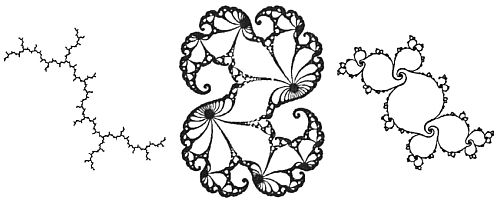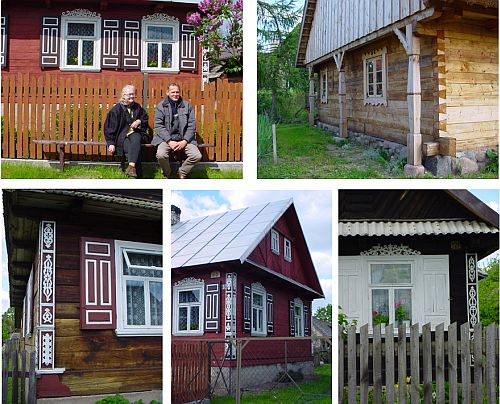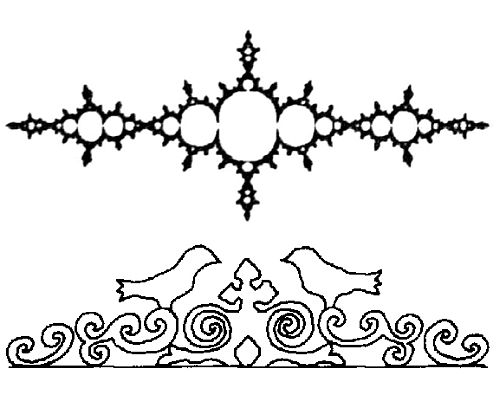1(6) 2009
 |
|
 |
ARCHITECTURE AND MODERN INFORMATION TECHNOLOGIES
МЕЖДУНАРОДНЫЙ ЭЛЕКТРОННЫЙ НАУЧНО-ОБРАЗОВАТЕЛЬНЫЙ ЖУРНАЛ ПО НАУЧНО-ТЕХНИЧЕСКИМ И УЧЕБНО-МЕТОДИЧЕСКИМ АСПЕКТАМ СОВРЕМЕННОГО АРХИТЕКТУРНОГО ОБРАЗОВАНИЯ И ПРОЕКТИРОВАНИЯ С ИСПОЛЬЗОВАНИЕМ ВИДЕО И КОМПЬЮТЕРНЫХ ТЕХНОЛОГИЙ
USING THE JULIA SETS IN SEARCHING FOR FORMS OF REGIONAL ARCHITECTURAL DETAILS
J. C. Zarnowiecka
Faculty of Architecture, Bialystok Technical University, Poland
Fractals – fractals architecture
Fractals belong to mathematical concepts which gained new value with the development of computer technology. The Julia sets (Fig. 1.) are among them (Gaston Julia – French mathematician). It should be remembered that, even though their existence and general shapes were known in the 1920s, it was only at the beginning of the 1970s that their unusual complex shapes were recognized. What had been started in the 1940s by Gaston Julia and Pierre Fatou was later developed by Benoit Mandelbrot, who gave the term ‘fractal’ to these unusual objects in 1975. The word itself comes from Latin ‘fractus’ meaning ‘broken’. A fractal is a figure which is geometrically torn, fragmented, and which may be divided into parts from which each is (at least approximately) a smaller copy of the larger whole. A fractal is also a dynamic object. It comes into being through a certain process. Without going into mathematical complexities of creating fractals, it is time to look more closely at one of the possible applications.
 |
Fig. 1. The Julia sets (Peitgen Jürgens Saupe 1992) |
The ongoing development of both hardware and software assisting the process of designing has caused changes in the technique of preparing a project. On the one hand traditional CAD software is modified towards a more convenient use by the designer. (Verbeke 1996, Rychter 1997) On the other hand, broadening the spectrum of software encourages one to search for new applications and new usages, also in design. (Bovill 1996, Zarnowiecka 2004) Recalling the notion ‘fractal architecture’, associations take us directly to Australia. It may be said that this unusual country-continent became a cradle of objects of architecture inspired by the geometry of fractals. The real fascination with this field of architectural inspirations, however, is connected with the development of modern computer tools and their use in architectural design. (Salingaros) The question here is: how can we use fractals in the regional architecture design?
Regionalism – regional architecture
In 2004 Poland joined the European Union. Even though the benefits of the new situation cannot be questioned, the Polish society voices fears of becoming a part of a large homogenous organism and thus a potential loss of Polish national identity. It is important for the nation to know and cultivate its language and tradition, which survived more difficult times of wars and partitions. Thus prominence needs to be given to cultural heritage and its protection. One of the values of national heritage is regional architecture. Its objects may be found in several rural areas in different parts of Poland, including North-Eastern Poland, the Podlasie Region. On the one hand the population in the area as well as the employment in agriculture decrease, on the other, the region has great natural resources. There are fragments of primeval forest (the Bialowieski National Park), wild river overflow areas (National Parks: Narwianski and Biebrzanski), lake complexes (The Route of Great Masurian Lakes) and others. To discourage the process of leaving the villages by their inhabitants, regional planning suggests the development of the service sector, with respect to services for local population and agriculture, but primarily to develop various forms of tourism.
The surviving element of regional architecture include: systems of house arrangements in villages1 , the system of the arrangement of buildings within the homestead, and architectural ornaments. (Zarnowiecka 2004) Diverse forms of ornaments to some extent clarify a division into areas of regional architecture (Fig. 2.). It is the architectural detail which reflects the specific climate of the region. Exact division of regions is not possible due to inevitable intercultural relations between neighbouring areas, the craftsmen’s mobility in looking for employment, as well as, for instance, a removal of wooden houses to new places. This last interesting phenomenon is observed in the Podlasie Region. Earlier this system of moving houses took place due to economic reasons and its aim was to save wood. This tradition continues, however, houses are still being moved, both onto new foundations as well as newly built cellars. Traditionally houses in the region were set directly upon the ground. The cellar was a separate object within the homestead.
 |
Fig. 2. Diverse forms of ornaments (2004) |
Conference papers often discuss chances for regional architecture resulting from the so called second homes, otherwise known also as summer houses. For the needs of summer retreat already existing houses are rebuilt or renovated towards their use in tourism. It also needs to be take into account that areas attractive for tourists have parts designated for new houses and thus new objects will be built, or old ones moved from their previous locations.
Investors have appeared, ready to buy a renovated house, a homestead or a manor located in the area attractive for tourists. Hence interest of the developers in modernization or rebuilding of the already existing objects of architecture with regional features. These activities should be preceded by the study of local architecture, types of buildings, ornaments used. The understanding of the features of local architecture will allow its preservation, its special look, sometimes even new creation on the basis the existing iconographic materials. In many cases this may be a chance to restore the cultural landscape.
Fractal and regional architectural details – ornaments
The study of the richness of traditional ornament in the Podlasie Region has demonstrated a similarity between selected Julia sets and the drawings of the outside ornaments above the windows. This similarity is particularly visible if we reject the lower part of one of the Julia sets, symmetrical towards the horizontal axis (Fig. 3.).
 |
Fig. 3. The Julia sets and traditional ornament |
On the other hand, among a great number of computer applications there are also such which allow transformation of one drawing into another. An experiment was carried out (Fig. 4.) in which a drawing of the window ornament was transformed into the Julia set (this activity can be reversed and the Julia set transformed into a window decoration). Since it is not a single Julia set that will be used as an ornament, each Julia set may constitute a basis for transformation. The essence of this experiment is to acquire a large number of variations. As a result there are many drawings resulting from transitional stages. This way of creating projects for ornaments could enrich details used, for instance, in houses in a specific village. The method would be particularly useful when the transformation concerns an ornament preserved in the specific area. The form and extent of the transformation would be decided upon by the designer, who would choose the most appropriate option. Thus the acquired detail could also serve to rediscover traditional ornaments. This would be essential in cases when details were damaged.
 |
Fig. 4. An experiment: the Julia sets versus traditional ornament |
A separate problem is constituted by the issue of how to make ornaments in the forms obtained by using fractal methods. As far as a traditional architectural detail was hand made, by an individual craftsman, a new detail may be created in a factory. A computer operated machine may produce the required ornaments according to the models on the drawings. (Table 1)
Table 1. Comparing the processes of design and production of regional architectural ornaments
| Ornament | Historical | Contemporary |
| Material | Wood | Wood |
| Tools for design | Pencil, compasses | CAD application, fractal transformation |
| Tools for production | Hand saw, mechanical saw | CAM – Computer Aided Manufacturing |
The example described above illustrates inclusion of computer tools towards efficient protection of regional heritage and shows a way of producing modern forms of regional ornaments.
____________________________
1 “ridge type arrangement of village houses” or “gable type of arrangement of village houses”
Acknowledgements
This work was supported by KBN, work number W/WA/08/05.
References
Bovill, C: 1996, Fractal Geometry in Architecture and Design, Design Science Collection, Harvard University.
Peitgen, H-O and Jürgens, H and Saupe, D: 1992, Fractals for the Classroom. Part 1: Introduction to Fractals and Chaos, Springer-Verlag, New York.
Rychter, Z: 1997, CAD as a Process of Software Development, in A Asanowicz and A Jakimowicz (eds), CAAD – Towards New Design Conventions, TU of Bialystok, pp. 233-241.
Salingaros, N.A: 1999, Architecture, Patterns and Mathematics, Nexus Network Journal, 1 (2).
Salingaros, N.A: 2001, Fractals in the New Architecture, Archimagazine.
Verbeke, J: 1996, Is CAAD enhancing the Design Process? in A. Asanowicz and B. Sawicki (eds), Proceedings of the IVth International Conference Computer in Architectural Design, TU of Bialystok, pp. 281-293.
Zarnowiecka, J.C: 1998, Chaos, Databasis and Fractal Dimension of Regional Architecture, in M Porada (ed), Proceedings of the 16th ECAADE Conference, Paris, pp. 267-270.
Zarnowiecka, J.C: 2004, Przestrzen informatyczna i architektura regionalna, Wydawnictwa Politechniki Bialostockiej, Bialystok.















